

Not every council site needs a full-sized speed hump. Some locations call for something less aggressive but still effective. Whether it’s a shared driveway, a laneway behind a community centre, or a car park next to a childcare facility, using the right traffic calming product can mean the difference between safety and risk. The key is to match the correct device to the specific problem.
We break down the difference between speed humps, rumble bars and rumble strips. Each one has its place, and each one is better suited to a particular type of council site.
Speed humps are raised rubber or plastic devices designed to slow vehicles to a crawl. Depending on the height and spacing, they typically bring vehicles down to around 10 to 20 km/h. They are effective because they leave no room for interpretation. Drivers must respond.
Speed humps are ideal for:
Why use them? Because they are non-negotiable. A well-installed speed hump physically forces drivers to reduce speed. In areas where pedestrians and vehicles often cross paths, like near playgrounds or footpaths, nothing is more effective.
If you want vehicles to reliably slow down without relying on signage or good behaviour, this is the tool.
Installation is straightforward with modular rubber units. These allow for flexible lengths and are more forgiving on uneven surfaces. The best-quality humps are rated to withstand heavy loads, such as those from garbage trucks and emergency vehicles. Some council-grade models are rated at 100 tonnes.
Just remember, speed humps are not for every location. Overuse in short laneways or already slow roads can lead to driver frustration and complaints. Emergency services may also request clear access routes without these devices. Use them where the risk demands it.
Rumble bars are narrow, raised bars installed in a row along the ground. They do not significantly slow a vehicle, but they alert the driver with a tactile vibration and audible rumble. Unlike full-speed humps, they are subtle and non-disruptive.
Rumble bars work well in:
These are great for edge control. You will often see them used to create a buffer near kerbs, poles or walls in tight turning spaces. When a driver gets too close to one side, the rumble bar makes contact before the wheel does. It acts as a warning before damage happens.
They are particularly effective when installed parallel to the path of travel, running along the edge of a lane. For example, we have supplied them to major brands like Guzman y Gomez and McDonalds for precisely this reason. The goal is not to reduce speed but to maintain lane discipline and reduce collision risk.
They can also be used to guide traffic around roundabouts, to separate parking bays or to mark zones that require caution visually.
They are not suitable as a standalone measure for reducing speed. If your goal is to reduce speeds by a significant margin, stick with a speed hump. But for guiding drivers and protecting infrastructure, rumble bars are an excellent low-impact solution.
Rumble strips are low-profile, ridged surfaces laid across the travel path. They produce both sound and vibration when driven over. You have likely encountered them on rural roads or near pedestrian crossings.
For councils, they are now being used more frequently in urban areas as well.
Rumble strips are well suited to:
They are effective because they trigger attention. Drivers may ignore signs, but they will feel and hear rumble strips. These are best used where you need to alert a driver rather than fully slow them down.
A typical setup involves three to five strips in sequence. They create escalating feedback to remind the driver to focus. In some cases, they are combined with warning signs or markings to draw attention to stop signs or pedestrian crossings.
Rumble strips are not loud enough to disturb surrounding properties, but are very effective inside the vehicle cabin. They also perform well in wet weather if made from highly slip-resistant materials.
Do not rely on rumble strips in high-risk zones with children or high pedestrian activity. They are a pre-warning, not a speed deterrent.
Use speed humps when you want to physically reduce speed. These are essential near childcare centres, libraries, strata complexes and other areas where people are frequently walking near traffic. Humps provide guaranteed slowdown.
Use rumble bars when the issue is driver awareness or wheel placement. These are excellent in tight spaces, drive-throughs, narrow turning lanes or around parking barriers. They are also helpful in marking boundaries in shared zones.
Use rumble strips when you need to grab the attention of a distracted driver. These work best before stop signs, crossings and exit lanes. They provide feedback without slowing the vehicle much and are a valuable tool in layered traffic calming plans.
The best councils use a mix of all three. The most effective strategy is to assess the specific risk and then match the product to the problem.
At Speed Humps Australia, we specialise in supplying traffic calming devices that are certified for use by councils. Our products are load-rated, modular, and tested to perform in high-traffic environments. From polyethylene and rubber humps to durable rumble bars, we supply councils across Australia with products that work.
We also offer free site inspections. After evaluating your website, our staff will suggest the best product for the task. No commitment. It’s merely sensible counsel from experts in what works.
Not every traffic issue needs a full-sized hump. But every high-risk zone needs something. Whether it is a strip to alert, a bar to guide, or a hump to slow, the right solution is out there.
If you manage council roads, car parks, or community zones, don’t leave it to chance. Use the right product. Make the right call. Keep people safe.
Contact Speed Humps Australia today to discuss your site or to book a free onsite inspection.



For 10 years, our focus has been on one thing: to provide one style of product and to do it well.
Our wheel stops, speed humps and rumble bars meet Australian Standards, don’t fade, and we’ve never needed to replace one.

For 10 years, our focus has been on one thing: to provide one style of product and to do it well.
Our wheel stops, speed humps and rumble bars meet Australian Standards, don’t fade, and we’ve never needed to replace one.